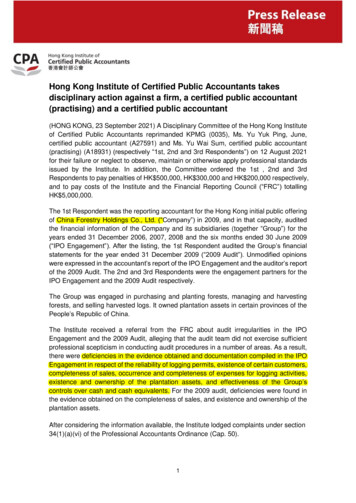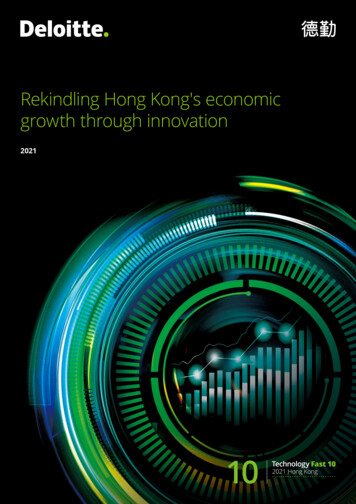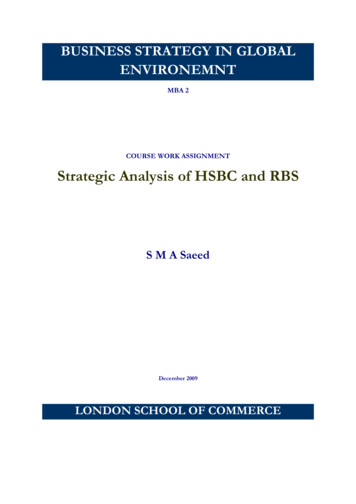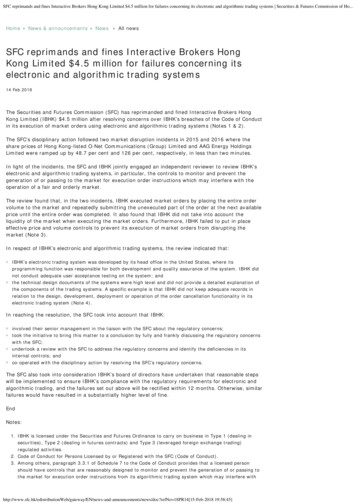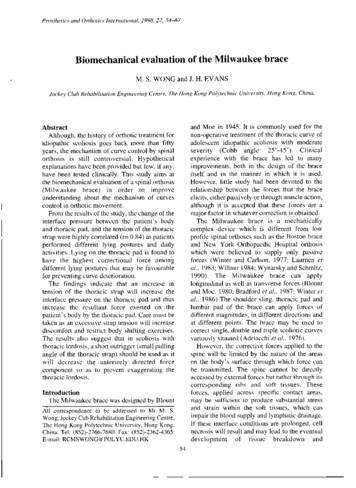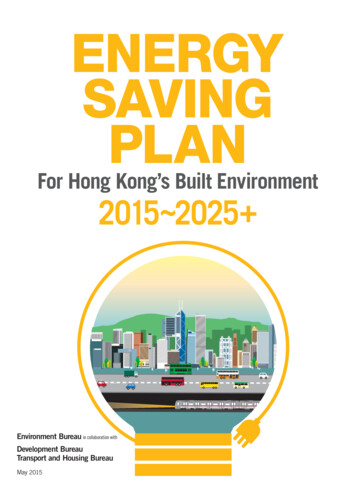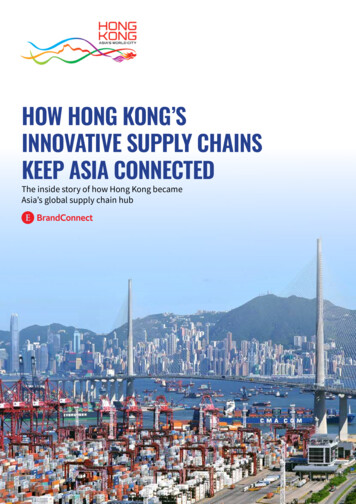
Transcription
HOW HONG KONG’SINNOVATIVE SUPPLY CHAINSKEEP ASIA CONNECTEDThe inside story of how Hong Kong becameAsia’s global supply chain hub
2CONTENTS34567810111213Executive summaryComplex supply chains, new challengesNatural selectionInstitutional advantagesConnecting East and WestAsia’s aviation and maritime hubsThe Asian opportunitiesHong Kong invested in smart opportunitiesSustainable supply chainsHong Kong, beyond boundaries2
EXECUTIVE SUMMARYHong Kong’s government is reinforcing its existing strengths—adependable legal system, attractive tax regime, business-friendlyenvironment and regulatory frameworks, and an existing ecosystemof service providers—with a series of policy initiatives designed tostrengthen the logistics and maritime sectors. It has introduced atax concession bill to attract ship leasing businesses and is the firstoffshore jurisdiction empowered to apply to Mainland Chinesecourts for interim measures relating to institutional arbitration.The city is also building on its geographic location, infrastructuralconnections and trade links by forming maritime and aviation pactswith Mainland China and Macao to boost ties with the GuangdongHong Kong-Macao Greater Bay Area.The world is demanding better supply chains in the midst ofCOVID-19, a US-China trade war, growing economic nationalismand the rise of e-commerce. In these uncertain times, businessesand governments alike look for safe, resilient partners that canoffer speed, stability and efficiency.This paper aims to explore how Hong Kong can help meet thisdemand for fast, efficient and sustainable supply chains. The cityhas the geo-strategic location and institutional advantages to addvalue throughout the supply chain. Already, Hong Kong’s airportis the world’s busiest air cargo handler, its port ranks within thetop 10 globally, and Hong Kong is a regional base for some of theworld’s biggest logistics firms.Supply chains will continue to evolve as they respond to bothmacro forces and consumer demand. Hong Kong will evolve too.Investing in its people, infrastructure and innovation to createdigital-first, sustainable supply chains will help ensure Hong Kongretains its status as Asia’s leading logistics hub.To ensure it maintains its position as Asia’s premier logistics,aviation and maritime hub, Hong Kong is investing in innovation,infrastructure and partnerships. Supply chain and logisticsstartups have been given a funding boost from the governmentin the latest budget round, the financial sector is growing tradefinancing, and a dedicated logistics and supply chain researchcentre is developing technological innovations to facilitate moreand faster trade between Hong Kong and Mainland China. Thecity’s airport authority is working with partners to get the latestaccreditations for speciality goods and expanding its capacity inpartnership with the world’s biggest logistics and delivery firms.3
4COMPLEX SUPPLY CHAINS,NEW CHALLENGESMOVING ONLINEBusinesses also need to take into account new demographics andmeans of doing business. In Asia, brands must contend with therise of new customer bases and rapidly evolving e-commerce.According to a 2019 McKinsey report, young consumers in China’slower-tier cities have been driving spending growth in the country.Meanwhile a 2020 Bain and Facebook study across six SoutheastAsian countries showed 30% of 8,600 digital consumers surveyedincreased their online spending over the past six months.COVID-19 DISRUPTS SUPPLY CHAINSThe COVID-19 pandemic is the biggest shock to the globaleconomy since the Second World War. Nations around the worldclosed borders and locked down cities to contain the outbreak.Factories halted operations and airlines stopped flying. TheWorld Trade Organization (WTO) predicted world merchandisetrade would fall 9.2% in 2020.The pandemic and fallout in trade hit supply chains hard.Today’s supply chains are complex, just-in-time systemsdesigned to cost-effectively meet consumer demands. Butthis optimisation makes them vulnerable to disruption. Bothnatural events, like floods and extreme weather, and risks, suchas cyber-security threats, geopolitical instability and tradewars, can lead to disruptions that raise costs, jeopardise globaloperations and affect the supply of goods. “The problems inthe supply chain were already there, but [COVID-19’s] level ofdisruption highlighted them,” says Jan Nicholas, partner atPricewaterhouseCoopers Consulting Hong Kong.“E-commerce accounts for only 14% of total retail salesworldwide, which shows there is still huge potential fore-commerce as a future growth driver for the industry,” says CheeChoong Ng, managing director of DHL Express HK and Macao.This is echoed by Alibaba’s logistics arm Cainiao Network, whichreported revenue of US 1.2 billion the quarter ending September2020—up 73% compared to the same quarter in 2019. Cainiao’s80,000 “Cainiao Post” stations, located in local communitiesacross China, recorded over 100% year-over-year growth inaverage daily package volume. “Driven by e-commerce and newretail, the whole logistics industry has been growing rapidly,” saysWan Lin, chief executive officer of Cainiao Network.CHALLENGE TO GLOBALISATIONThe global pandemic has also exacerbated a shift towardseconomic nationalism and protectionism. In the US-Chinatrade war that began in 2018, America slapped tariffs onChinese imports, which led to a sizeable reduction in tradebetween the two countries in 2019. More uncertainty wasadded to the global trading system when the US blocked thenomination of judges to the WTO appeals board, affecting itsability to adjudicate trade disputes.DEMAND BETTER SUPPLY CHAINSIt is too soon to tell what the long-term impacts of COVID-19,geopolitical tensions or the growing importance of young, digitalfirst consumers will be. But the world is demanding better supplychains, as efficiencies generated by specialisation and timesensitive resupply are measured against the chain’s weakest links.There is a pressing need for secure, connected and efficientlogistics and supply chain management hubs. In Asia, Hong Kongplays that clustering role. It offers a strategic location, excellentconnectivity, state-of-the-art infrastructure, a sound legal system,high-quality service providers, simple tax regime, and a reputablestatus as an international business and financial centre.Businesses now have to consider distant disruptions to theirsupply chains and the risks from economic nationalism. HongKong’s Secretary for Commerce and Economic Development,Edward Yau, said that in recent years, the rise of protectionistmeasures and the failure of the multilateral trading system haveposed unprecedented challenges to free and unimpeded trade.4
NATURAL SELECTIONHong Kong’s natural advantages extend well beyond theGBA—its geographical location at the heart of Asia connectsbusinesses to customers across the region. One of the world’sbusiest and most efficient ports, its sheltered harbour anddeep-water draft means “Hong Kong is able to stay in the gameas vessels upsize” says Andrew Hoad, Asia-Pacific managingdirector at multinational logistics company DP World.The dynamics of global trade may be evolving, but HongKong’s natural advantages as a connected hub for Asia remain.The city has a long history as a trading entrepôt betweenEast and West; is a key player in the Guangdong-Hong KongMacao Greater Bay Area (GBA), with its combined GDP ofaround US 1.6 trillion and more than 70 million people ; andsits across a nexus of routes—connecting sea, river, road,air and rail links. “In Asia there is almost no better location,”says Wolfgang Lechmacher, a supply chain and technologystrategist. And this location has made the city a first mover inlogistics and supply chains for China and the world.Hong Kong’s position on China’s south-eastern flank alsomeans it is within five hours flying time of half of the world’spopulation. Even today, trading and logistics is the biggest ofthe city’s four economic pillars—surpassing even finance—accounting for 21% of the city’s GDP in 2018.HONG KONG: CONNECTING THE WORLDEUROPEASIAAFRICAAUSTRALASIA/PACIFIC ISLANDS30 destinations5 destinations142 destinationsNORTH,CENTRAL ANDSOUTH AMERICA30 destinations12 destinationsHONG KONGAIRLINES: 120DESTINATIONS: 2205
INSTITUTIONALADVANTAGES“The intersection of the physical supply chain and the financialinstitutions puts it in a natural position to be a leader,” saysMr Nicholas. “There are few places in the world that have thatability to do it.”Along with its natural advantages, Hong Kong also boastsinstitutional advantages. It is a financial hub and free-marketeconomy with limited tariffs or taxes and has an extensive talentpool to draw on from the dynamic supply chain managementand logistics ecosystem. This makes Hong Kong attractive tocompanies wanting to either do business in Mainland China oruse the city for their regional headquarters. “Hong Kong’s freeport status is the most significant unique selling point—exportsand imports are not held up at customs,” says Mr Hoad. “This isvery appealing for shipping lines and shippers to ‘catch up’ ontheir schedule and to ship their just-in-time cargos.”HONG KONG’S TOTAL(INWARD AND OUTWARD) FREIGHT MOVEMENTSMillion(tonnes)SeaborneHong Kong-based businesses add value along the wholesupply chain. Their strength in financial and advisory servicesmeans they can focus on the high-value end of the chain, bothwithin Hong Kong and beyond. In 2020, the Fraser Instituteand the Heritage Foundation ranked Hong Kong as the world’sfreest and second freest economy respectively. The city’sinfrastructure is highly developed, and its legal and compliancesystems are highly alNote: *The amount of freight excludes air mailSource: Summary Statistics on Port Traffic of Hong Kong, Transport andHousing Bureau6
CONNECTINGEAST AND WESToptimise the business environment for maritime companies.This followed on from the GBA Airspace CollaborativeDevelopment pact signed last year between aviation officialsfrom Mainland China, Macao and Hong Kong to promotetechnical expertise, collaborate on training and introduce newtechnologies between them. “The strategy is to build and useand leverage the facilities next door,” says Nicholas Kwan,director of research at the Hong Kong Trade DevelopmentCouncil. “That’s why the GBA is important.”The unique combination of supply chain expertise andgeographic proximity enables Hong Kong to act as a repositoryof institutional knowledge and conduit to and from MainlandChina. The city’s proximity to Mainland China means HongKong business leaders, entrepreneurs and logistics expertshave had decades of working with Mainland manufacturers andsuppliers, says Mr Nicholas. This has built up a logistics skill-setthat connects the Chinese market to the West. Businesses arealso able to make use of new infrastructure, such as the HongKong-Zhuhai-Macao Bridge that connects the GBA’s easternand western banks.Businesses are also able to use Hong Kong to expand theiroperations beyond China, to the Asia-Pacific region andfurther afield. Hong Kong companies now run some of thelargest supply chain and logistics firms in the world. “Theyeither own the factory directly or handle the distribution ofthose products, the branding, distribution, marketing, design,logistics support,” said Mr Kwan. For example, Hutchison Portsis a home-grown Hong Kong business that is now the world’sleading port investor, operating 52 ports in 26 countries.Flagship initiatives like the GBA and the Belt and Road Initiative(BRI) also allow Hong Kong-based businesses to deliver highquality logistics services. In 2020, the Ministry of Transportof the People’s Republic of China signed an agreement withHong Kong and Macao’s maritime authorities to establisha collaborative mechanism and jointly maintain watertransportation safety in the GBA, promote green shipping and3.1% OF GDPIn 2018, the logistics industry contributed3.1% of Hong Kong’s GDP and 176,900 jobs7
ASIA’S AVIATIONAND MARITIME HUBSIn 2019, Hong Kong managed around 4.8 million tonnes of air cargo and over 18 million twentyfoot-equivalent units (TEUs) of ocean freight. Building on its core competencies as a world-classtranshipment hub, a pipeline of logistics talent, a centre for supply chain management and itsdevelopment of smart supply chains and e-logistics, Hong Kong continues to strengthen its positionas a global logistics hub in the aviation and maritime sectors.ASIA’S AVIATION HUBAnother organisation that has made Hong Kong a key gateway intothe region is DHL, which has set up its Central Asia hub in the city.Hong Kong already handles more than 40% of DHL’s volume in theAsia-Pacific area. As one of three global hubs for DHL, its CentralAsia Hub connects with more than 70 DHL Express gateways in theregion and its expansion will support the growth anticipated whenthe three-runway system is operational. “Hong Kong is an idealsourcing hub and distribution centre for businesses in the region,especially for high-value goods including fashion and consumerelectronics that need to minimise inventory and catch producttrends,” says Mr Ng.Connected, efficient and with unparalleled cargo-handlingcapacity, Hong Kong International Airport (HKIA) has been theworld’s top cargo handler for 10 years since 2010. To maintainits position, HKIA is embracing new technologies, includingautonomous vehicles, robotic-serving devices, facial recognitiontechnology and an in-airport 5G network. This is supplementedby infrastructural projects, such as the three-runway system thatis scheduled to be completed in 2024.As Asia’s aviation hub, Hong Kong focuses on high-value aircargo and logistics services. To support this, the airport workswith their air cargo community, including some of the world’slargest logistics and delivery firms, to stay agile and respondto changes in global trade. For example, Cainiao Network, thelogistics arm of Alibaba Group, is leading a consortium to builda smart logistics hub at HKIA. The digital logistics centre willfeature automated temperature controls and cutting-edgerobotics. To cut costs and delivery times, many goods will be“agglomerated” from the Alibaba economy in South China andflown twice daily from Hong Kong to Cainiao’s eHub in Liege,Belgium and then on to the European market.SMART AIRPORT FOR A SMART CITYNew digital initiatives are radically changing the airport’s supply chainprocesses. Over the past 12 months Hong Kong Air Cargo TerminalsLimited (Hactl)—HKIA’s largest independent cargo handler—haslaunched “Smart Cargo Locating”. This home-grown system usesradio frequencies and barcodes to help assemble goods faster forflights, as well as e-loading for stacking pallets onto freighters andproviding real-time updates. Hactl also uses artificial intelligence (AI)to spot any defects in their equipment before they cause breakdownsor disrupt operations, says Wilson Kwong, chief executive of Hactl.120 AIRLINES,220 DESTINATIONSConnected to Asia and the world,about 120 airlines fly to some220 destinations from HKIA4.8 MILLION TONNESVolume of total cargo throughputHKIA handled in 20198
Maritime businesses like Mr Chao’s are reinventing themselvesby diversifying their base. Wah Kwong is adding assetmanagement to its ship-owning activities, creating value out oftheir expertise and reputation. They have doubled the numberof ships they manage within two years, adding 10 this year,and are seeking to grow their fleet to 80 ships by the end of2022. They are also building partnerships to educate the nextgeneration of seafarers, with a training centre in Weihai and alink with Shandong Jiaotong University.There is market demand for high-end, temperature-controlledshipping in aviation. Agricultural produce and pharmaceuticalproducts alike need to be delivered in a secure, speedy mannerand with the right accreditation. To meet this need, Hactl wascertified as a Center of Excellence for Independent Validators(CEIV) Fresh by the International Air Transport Association.Hactl is one of the first two cargo handling agents in the worldto receive this CEIV Fresh accreditation. It was awarded afteran assessment of Hactl’s training, technology and processes,including a fast-track “Fresh Lane” that minimises the amountof time perishable goods are being unloaded or transferred. Thisfollows on from Hactl’s “Golden Route” for expedited handling ofpharmaceuticals in 2013. HKIA also set up an airport-to-airportpharma corridor with Brussels Airport in 2019.These kinds of partnerships build on the Maritime and AviationTraining Fund (MATF), which was set up in 2014 by the Transportand Housing Bureau to address the longer-term needs ofthe industry and to nurture and attract talent. Last year, thegovernment injected US 25.8 million into the MATF to nurturea competitive pool of technical and professional personnel.A “Talent List” for fast-track immigration, which includesmarine engineers, ship superintendents and marine insuranceprofessionals, was also established in 2018.ASIA’S MARITIME HUBHong Kong is already a leading centre for shipping andcommercial contract formation and arbitration. New governmentinitiatives, most recently the Inland Revenue (Amendment) ShipLeasing Tax Concessions Bill 2020—intended to attract shipleasing businesses to the city—should reinforce this position.SAFE HARBOUR, SMART PORTSThe city’s ports have always been attractive due to their free portstatus and world-class customs clearance. To further increaseefficiencies and save costs, four operators at Kwai Tsing ContainerTerminals joined forces in 2019 to form the Hong Kong SeaportAlliance. Here, operators pool their resources, including 23 berthsand other yard facilities, to boost operational flexibility. “We havereduced inter-terminal trucking by close to 50%, which helpsimprove efficiency, cut costs and reduce carbon emissions,” saysHorace Lo, group managing director of Modern Terminals Limited.The alliance now has twice the capacity of electrical power pointscalled “reefer points” to serve refrigerated containers than anyother terminal in South China, he adds.Hong Kong was also recently designated by the Baltic andInternational Maritime Council (BIMCO) as an arbitration centre,alongside London, New York and Singapore. And, as the firstoffshore jurisdiction empowered to apply to Mainland Chinesecourts for interim measures relating to institutional arbitration,Hong Kong has become more attractive to Chinese shippers as acentre for arbitration.“These measures are important ways to capitalise and build onHong Kong’s core strengths and will serve to enhance our overallcompetitiveness and position as an international maritime hub,”says Hing Chao, chairman of Wah Kwong Maritime Transport.As part of the government’s drive to digitise all aspects of HongKong’s supply chain, the city’s ports are also becoming smarterand faster. “Increasingly, those who manage freight for cargoowners offer an integrated digital platform that allows truckmoves, barge moves, terminal handling and ocean legs to beviewed and managed with a combination of track and trace,documentation and financial services,” says Mr Hoad.The port and shipping industries have needed to adapt to thechallenges of COVID-19 and the increased costs of changingcrews amid travel restrictions, says Mr Chao. An uncertain globaleconomic outlook has added a further element of risk to thealready volatile shipping industry, he adds.THE SIZE OF HONG KONG’S LOGISTICS INDUSTRY: EXPORTS2015201620172018Sea transport servicesHK 115.3bn(US 14.8bn)*HK 107.3bn(US 13.8bn) HK117.2bn(US 15bn) HK127.3bn(US 16.2bn)Air transport services HK93.0bn(US 11.9bn) HK88.8bn(US 11.4bn) HK95.6bn(US 12.2bn) HK106.1bn(US 13.5bn) HK14.5bn(US 1.8bn) HK14bn(US 1.8bn) HK15.2bn(US 1.9bn) HK15.4bn(US 1.9bn) HK3.94bn(US 508.2m) HK4.47bn(US 575.8m) HK5.2bn(US 667.3m) HK5.2bn(US 663.4m) HK230.9bn HK218.7bn HK237.4bn(US 29.7bn)(US 28.1bn)(US 30.4bn)* All US conversions are based on historic exchange rates HK258.8bn(US 33bn)Cargo forwarding servicesPostal and courier services**Total transport services exports** Service exports by Hong Kong Post not includedSources: Report on Hong Kong Trade in Services Statistics, Census and Statistics Department9
THE ASIAN OPPORTUNITIESThe global economy is predicted to remain in a recessioninto 2021, but there are signs of a China-led Asian recovery.According to government data, the Chinese economy grew 4.9%between July and September 2020, and China’s trade jumpedin September with exports up 9.9% from the year before andimports rising 13.2%—potentially making it the first majoreconomy to recover from the COVID-19 fallout.Hong Kong is ideally positioned to take advantage of the MainlandChina supply chain opportunity. Within the GBA, each major city isidentified as having different specialities. For example, while HongKong itself has limited space for warehousing, it can leverage GradeA warehouse space in the logistics hubs of Foshan, Guangzhouand Dongguan. “We can hardly live without Shenzhen these days,and the same for them, because our factories are in Shenzhenand the communications and marketing arms are here,” says MrKwan. Transport and logistics are identified as a key policy area forHong Kong under the GBA plan, with a focus on the city as a globalaviation hub, global maritime centre and regional logistics hub.Some companies may be mitigating their overreliance onChina—a 2020 Gartner survey found that 33% of supplychain leaders had moved, or plan to move, sourcingand manufacturing activities out of China by 2023 —butreconfiguring global supply chains is time-consuming andexpensive. “The global supply chain is a big ship to turn andit turns pretty slowly,” says Mr Nicholas. Most products aremade up of parts from all over the world and attempts to moveproduction back home could lead to a rise in cost or a dropin quality, adds Mr Lechmacher. A 2020 survey by the AsiaBusiness Council also showed that most CEOs were optimisticabout China, with 72% saying they had not considered shiftingproduction or reducing reliance on China.Asia too is becoming more important as it moves from beingthe factory of the world, to being the marketplace instead. Fundmanager Fidelity International identifies a growing middleclass in Asia who are buying more consumer goods, growingthe market and providing the region with a source of resilience.“While Hong Kong has benefited in the past as the gatewayto China, we’ve been seeing growth in intra-Asia trade,” saysMr Lo. “Hong Kong will continue to adjust and capture growthopportunities in intra-Asia.”HONG KONG ALWAYS DELIVERSquickly offered appropriate support. For example, the increasein e-commerce led to a surge in cargo demand that meantairlines needed to arrange extra cargo flights. In response, theCAD re-deployed extra manpower to process flight applicationsand expedite airlines’ applications for the operation of cargoflights to and from the airport. Between February and August2020, the CAD handled applications for nearly 12,000 extrasection and charter all-cargo flights. As a result, from Februaryto August 2020, express cargo shipments jumped more than20% over the same period last year.During COVID-19 lockdowns, customers around the worldturned to online shopping. Companies needed to fulfil theseorders, but many faced issues with delivery. For example,a large number of passenger flights, which carried around40% of all cargo in and out of HKIA in 2019, were temporarilysuspended due to travel restrictions imposed by governmentsof various countries and places.Hong Kong Civil Aviation Department (CAD) closely monitoredthe air cargo demand and operational needs of the airlines and10
HONG KONG INVESTEDIN SMART OPPORTUNITIESAmid shifting market demands, Hong Kong sees the logisticssector as a priority for the city’s ongoing development andprovides top-down support and investment. In late September,Financial Secretary Paul Chan said Hong Kong needed to“maintain Hong Kong’s key—even leading—position in theglobal supply chain, capital flow and technology race.” Thegovernment allocated HK 345 million (US 44.5 million) in the2020 budget to boost technology in the logistics industry.than HK 697.6 million (USD 90 million) in funding from theInnovation and Technology Fund. Several supply chain-relatedtechnologies have been developed by LSCM. These include ane-lock to monitor and safeguard the security of cargo by bothHong Kong and Mainland China customs authorities under the“Across the Boundary with One Single E-Lock under SeparateMonitoring” principle. Meanwhile a one-stop e-platform uses AIto analyse data and translate languages for international trade.Across the supply chain sector, companies are utilisingpredictive intelligence and data analytics to make fasterdecisions, increase speed to consumer, improve productivityand reduce supply and demand volatility. Moving into this fieldwill be crucial for Hong Kong to keep thriving. “Hong Kong canstill grow its pie—the airport can still grow, the port can stillgrow, the trucking industry can still grow—but it has to find newlayers of activity,” says Mr Lechmacher. “Because the world isgoing digital, Hong Kong needs to see how to fit in.”“Logistics and the supply chain practitioners must upgrade theircapability so that they can work with the e-market platforms, aswell as e-logistics, so that everything will become frictionless;as smooth as possible, as fast as possible and as technical aspossible to give the best service to the customers,” says LSCM’schief executive officer, Simon Wong.Hong Kong also has a vibrant ecosystem of shippers and logisticsproviders, logistics-related tech startups and entrepreneurs, anddedicated governmental support and resources. According to thegovernment’s StartmeupHK scheme, there were 342 startups ine-commerce, supply chain management and logistics technologyin 2019. Logistics companies like Cainiao are also investing timeand money to help Hong Kong digitise its supply chains. “[Cainiaoaims to] become an engine for digital transformation of theindustry by leveraging cutting-edge technologies to reinvent everycomponent along the value chain,” says Mr Wan.To deliver this digital future, Hong Kong has public-privateacademic support in research and development (R&D) andsupply chain digitisation through the Logistics and Supply ChainMultiTech R&D Centre (LSCM). One of five R&D centres set upby the Hong Kong SAR Government, LSCM has conducted morethan 160 projects, supported by industry, academia and thepublic sector. These projects have also benefited from moreHOW HONG KONG FINANCES TRADEtrade finance processes. To facilitate cross-bordertrades, eTradeConnect is now connected to the People’sBank of China Trade Finance Platform, allowing importersand exporters in the global supply chain to obtain moreconvenient trade finance services through banks inboth places.With so much trade flowing through its ports and airports,Hong Kong is investing in new technologies to provide more,better and faster trade finance products.The city’s monetary authority has facilitated the creationof eTradeConnect, a blockchain-based trade financeplatform developed by a consortium of twelve majorbanks in Hong Kong. The platform aims to improvetrade efficiency, build trust among trade participants,reduce risks and facilitate trade counterparties to obtainfinancing by digitising trade documents and automating“By providing the financial infrastructure to support thesupply chain participants, they are furthering Hong Kong asa trade and supply chain hub, and helping grow the flow ofgoods through Hong Kong,” says Mr Nicholas.11
SUSTAINABILE SUPPLY CHAINSexecutive director, commercial at the Airport Authority Hong Kong.As part of its “green terminal” campaign, Hactl has erected 516 solarpanels on 1,600 square metres of rooftop, making enough electricityto power 32,000 5W lightbulbs at the same time. By managing itsenergy, Hactl saved US 950,000 in 2019, says Mr Kwong, and reducedcarbon emissions by an amount that would take 280,000 trees ayear to absorb. This comes on top of other initiatives that includeswitching to LED lights, using electric vehicles and phasing out singleuse plastics.Sustainability is an ever increasing consideration for supply chainsand logistics businesses. The transporting of goods within the supplychain is one of the biggest carbon emitters, Mr Lechmacher says.As part of its “Greening Hong Kong” initiative, the governmenthas pledged to balance economic, environmental and socialconsiderations in development. For example, by pooling 23 berthsto serve its shipping line customers, the Hong Kong Seaport Alliancehas cut 1,000 hours of vessel waiting time, saving 37,000 tonnes ofmarine fuel each year, according to Mr Lo. This drop in waiting timealong with a decrease in inter-terminal trucking has also allowed thealliance to cut 130,600 tonnes of carbon emissions per year.Taking the environment into account is a big opportunity for businessand for Hong Kong. “It’s a job creator, an innovation and imagedriver,” says Mr Lechmacher.Meanwhile, Hong Kong’s airport has a goal to be one of the world’sgreenest airports. One of its green initiatives is to replace its fuelpowered fleets of cars with electric vehicles, says Cissy Chan,90% IMPACTAccording to McKinsey, 90% of a typicalconsumer company’s impact on the environmentcomes from its supply chains12
HONG KONG,BEYOND BOUNDARIESHong Kong has natural and structural advantages that make itone of the leaders in global supply chains. The city of 7.5 millionpeople is able to add value to the logistics and supply chains farbeyond its boundaries, with its business connections reachingdeep into Mainland Chinese cities and beyond. “Hong Kong’sintegrated business service
This paper aims to explore how Hong Kong can help meet this demand for fast, efficient and sustainable supply chains. The city has the geo-strategic location and institutional advantages to add value throughout the supply chain. Already, Hong Kong’s airport is the wor
